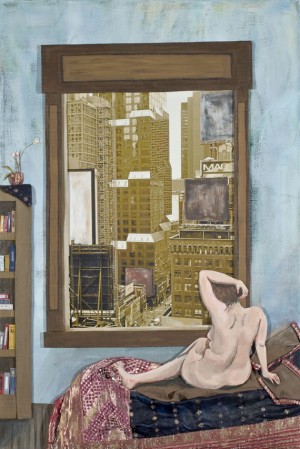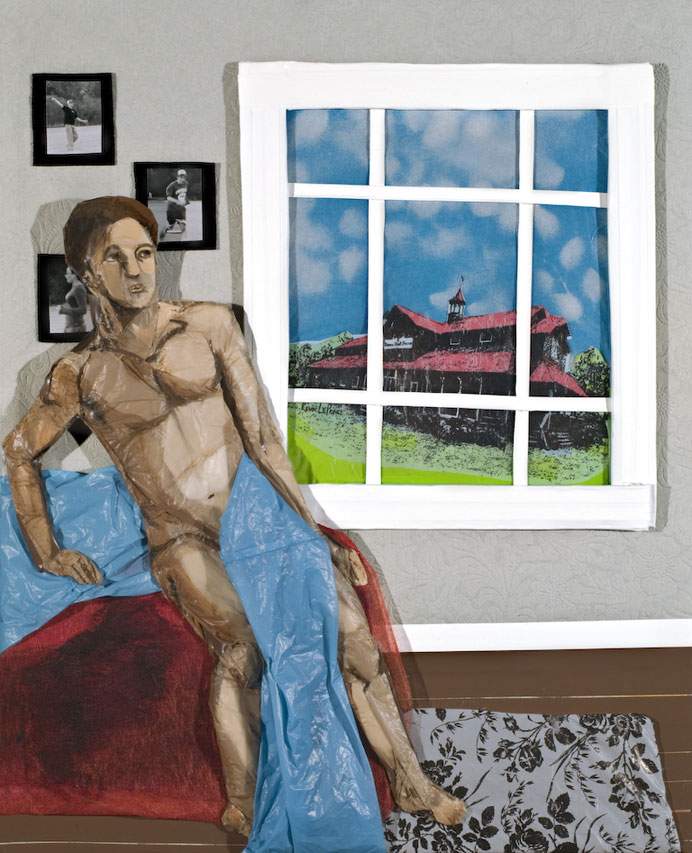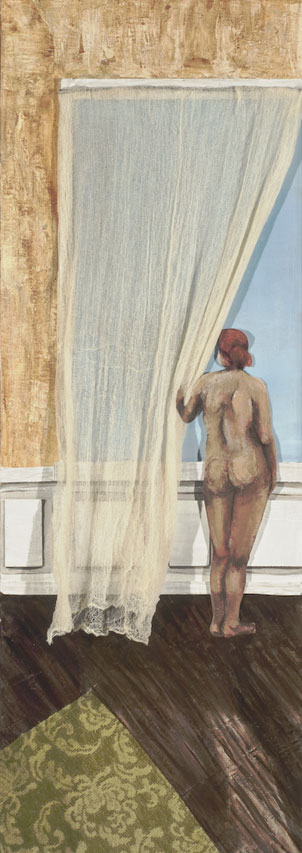On one of the days when I was delivering our December 2008 issue of Carolina Arts, I stopped at the Charleston County Public Library’s Main Branch in downtown Charleston, SC to leave copies of our paper. This is not something I can do in every library across the Carolinas. Did you know that some library systems in both North and South Carolina will not let us leave papers at their library branches. Most of the time it’s not because they don’t like our paper, but it’s the only way they can keep other papers out of the library. It’s censorship by association, which is not so cool but understandable after viewing some papers out there. This is not the case in Charleston.
After dropping off papers I went to check out the current exhibit up in the Saul Alexander Foundation Gallery. The December 2008 exhibit was Places and Faces, featuring mixed media works and some portraits by Liza Twery of Charleston.
A handout offered at the exhibit provided the following info: “Influenced by a family of accomplished artists, Liza grew up amidst the Blue Ridge Mountains of central Virginia. She moved to the Lowcountry in 2002 and earned a BA in Studio Art and Arts Management from the College of Charleston. In 2005, she lived in Florence, Italy, where she studied the visual arts at the prestigious Firenze Arti Visive. There she began her personal exploration of layering and experimenting with a variety of materials. In her work Liza has been known to use tissue paper, tape, glue, and recycled materials such as plastic bags. From the home of an Italina contessa to the quaint shops of the Charleston Market, Liza’s work is displayed and appreciated all over.”
It was Twery’s unusual use of materials that caught my interest while viewing her exhibit. She used a variety of materials not often seen in paintings. In one image a man was rising out of bed – his body was made of what seemed like some sort of plastic material, which I later figured might have been a plastic grocery bag. I’m no artist, but I figure that was harder to do than just painting a man’s body. Maybe not, but I couldn’t do either. The sheet/blanket from the bed was also some kind of plastic material – which makes sense – plastic body – plastic sheet – think of a sheet that is skin soft. Now wouldn’t that be a nice sheet or blanket?
In another scene a naked woman is looking out a very large window – the drape is actually made of a materials that is often used for window sheers. A rug on the floor is some material which has a pattern of a typical patterned rug.
Twery supplied me with three images from this exhibit. All three scenes suggest situations where people have perhaps been sleeping in a room – just awakening. Each room has a window to look out at various views – an urban view, a blank blue sky (maybe at the beach) and a rural farm or stable view. The rooms and objects in the rooms are made up of various materials or images from other images – none of the three would suggest wealth or a longtime residence – like these could be first time apartments or even dorm rooms.
Twery also offered some images which were like portraits of different people, but they all shared the same eyes or look in their eyes. I looked around the gallery space and noticed that there was something about the eyes in all images that showed people looking out of image. What the message is here I don’t know, but I’m sure the artist has a story about the eyes. Maybe it’s that she thinks all people see her the same way – with no imagination or that all her subjects begin to all look the same once they enter her art. Who knows, but once you notice the eyes, it’s hard not to notice them. Some people say you can tell a person by their eyes – maybe Twery is protecting the innocent people (in real life) who are being depicted in her art world. I’m just saying – check out the eyes – they have a look about them.
So here is another little exhibit at the library worthy of your time to go see. You can make your trip a little more worthy by picking up a good book, a CD or a DVD and the first hour of parking is free. Throw in a public rest room and a copy of Carolina Arts and you have gotten a big bang for your buck – Oh that’s right, everything I’ve mentioned is free – or at least most of it is – if you don’t have a library card, but then why wouldn’t you? I can’t imagine why you wouldn’t.
So go see the exhibit – it’s up through December.
P.S. Two extras. Liza get extra points for knowing the correct spelling for the “Lowcountry” even though she is not a native. And the story about the eyes reminds me of a little story from my photography days. I mentioned the eyes of the people in the images looking out of the images – of course you can’t see the eyes of the people looking away.
I once worked in a photo processing shop where people brought in file to have it processed and then have pictures made – I’m talking decades ago, long before the digital world we all live in now. An older woman had picked up some slides or transparencies (these are positives films that people used to show in projectors). She had a slide on a light box and kept turning it over and over. I went up to her and asked if I could help her or if there was a problem and she asked which way she had to turn it to see the person’s face? I looked down and it was an image of the back of a person’s head, but she wanted to see the face. I offered an explanation as to why that wasn’t possible that didn’t go over very well and retreated to a back room before I busted a gut, but later in life came to the conclusion – what a tragedy of the technology of photography that the camera couldn’t take both sides of any scene – so we could see what the photographer didn’t want us to see, but then – isn’t that what every artists is doing? They only show us what they want us to see and do we even see it – right in front of us? Makes you wonder.


